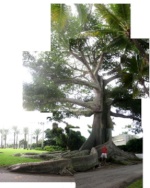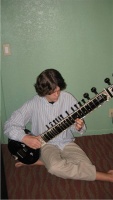Just curious
+4
Fuzzy
David Brunner
sitarbonsai
ydde72183
8 posters
Page 1 of 1
 Just curious
Just curious
Just a random question. If you took a tree and slowly tilted it (over a couple of years and a couple of repots), could you eventually turn the tree completely upside down? Would the roots eventually become the top and vice versa? could a tree reverse itself like that and rearrange itself? THis is purely a question born from curiousity. Could it work?

ydde72183- Member
 Re: Just curious
Re: Just curious
Hello Ydde72183,
If I understand the question that you posed, the answer is no; notwithstanding the incredible artistry of Mr. Kimura that Sitarbonsai showed us. In plants, the anatomy and function of roots and branches are very different and except for very rare cases are not interchangeable or reversible. In the work from Mr. Kimura, it’s the deadwood that has been turned upside down, but the live branches were grown from previous branch (or trunk) tissues and the roots from previous root tissue. In some cases a tree can produce root tissue from a branch (like aerial roots in figs) or stem tissue from roots (like waterspouts in cottonwoods and aspens) but if you turned the whole thing upside down with the roots in the air and the branches beneath the soil (even if done over a long period) the tree would not survive. There is a bonsai technique that comes close to this though and that is the raft, in which the trunk is horizontal with the soil surface and the branches on one side of the original trunk are trained into a forest planting. If done well and with a suitable species, the buried side of the original truck will produce new roots and the original root ball may be able to be removed. (But just so its clear, the new roots from the trunk won't be the old branches, they will be new growth.)
I hope this was helpful and that I appropriately understood your question,
David Brunner
If I understand the question that you posed, the answer is no; notwithstanding the incredible artistry of Mr. Kimura that Sitarbonsai showed us. In plants, the anatomy and function of roots and branches are very different and except for very rare cases are not interchangeable or reversible. In the work from Mr. Kimura, it’s the deadwood that has been turned upside down, but the live branches were grown from previous branch (or trunk) tissues and the roots from previous root tissue. In some cases a tree can produce root tissue from a branch (like aerial roots in figs) or stem tissue from roots (like waterspouts in cottonwoods and aspens) but if you turned the whole thing upside down with the roots in the air and the branches beneath the soil (even if done over a long period) the tree would not survive. There is a bonsai technique that comes close to this though and that is the raft, in which the trunk is horizontal with the soil surface and the branches on one side of the original trunk are trained into a forest planting. If done well and with a suitable species, the buried side of the original truck will produce new roots and the original root ball may be able to be removed. (But just so its clear, the new roots from the trunk won't be the old branches, they will be new growth.)
I hope this was helpful and that I appropriately understood your question,
David Brunner
David Brunner- Member
 Re: Just curious
Re: Just curious
My first response to this question was why would you want to? Then it got me thinking so here goes. A full cascade could be a rough example of what you are saying supposing the foliage started and finished below the bottom of the pot. In this instance the roots are technically growing above the foliage. 

Fuzzy- Member
 Re: Just curious
Re: Just curious
David Brunner wrote:Hello Ydde72183,
If I understand the question that you posed, the answer is no; notwithstanding the incredible artistry of Mr. Kimura that Sitarbonsai showed us. In plants, the anatomy and function of roots and branches are very different and except for very rare cases are not interchangeable or reversible. In the work from Mr. Kimura, it’s the deadwood that has been turned upside down, but the live branches were grown from previous branch (or trunk) tissues and the roots from previous root tissue. In some cases a tree can produce root tissue from a branch (like aerial roots in figs) or stem tissue from roots (like waterspouts in cottonwoods and aspens) but if you turned the whole thing upside down with the roots in the air and the branches beneath the soil (even if done over a long period) the tree would not survive. There is a bonsai technique that comes close to this though and that is the raft, in which the trunk is horizontal with the soil surface and the branches on one side of the original trunk are trained into a forest planting. If done well and with a suitable species, the buried side of the original truck will produce new roots and the original root ball may be able to be removed. (But just so its clear, the new roots from the trunk won't be the old branches, they will be new growth.)
I hope this was helpful and that I appropriately understood your question,
David Brunner
Hey, David
I to also don't think it is possible
at least not with a large percentage of species
I just remembered Masahiko Kimura saying that he "reversed sky and earth" he also added that "now everybody knows how to do this and this tree is very popular" I sure don't know how!
here is the link if anybody is interested:
https://www.youtube.com/watch?v=Eq8eb2XK9Jw
he talks about it starting at 2:15
hope you enjoy,
Justin

sitarbonsai- Member
 Re: Just curious
Re: Just curious
The two biggest problems one would encounter are nutrient aquisition and the search for light. I guess the best example I can think of is the "topsy-turvey" planter, we have one. You plant the tomotoes upside down. Even though the top grows below the root, the roots still require soil and fertilizer and if you were to remove the roots from the soil, the plant would soon die. The top, appears to be growing downward and the weight of the fruit can assist in the downward forces on the branches; however, the new growth continues to attempt to reach upward in the direction of the light.
Now, lets throw some monkey wrenches into the cogs...Most trees, if you surround a branch with a dark moist media are capable of growing roots, and most roots, if cleaned and exposed to light and air will harden and form branch-like qualities and may even back bud.
So, what's the definitive answer? HMMMMM!
Now, lets throw some monkey wrenches into the cogs...Most trees, if you surround a branch with a dark moist media are capable of growing roots, and most roots, if cleaned and exposed to light and air will harden and form branch-like qualities and may even back bud.
So, what's the definitive answer? HMMMMM!

Jay Gaydosh- Member
 Re: Just curious
Re: Just curious
I’ve just come back from walking the dogs on a local beach and guess what I saw, A small tree growing at an acute angle downwards due to it growing on a cliff face where soil erosion has gradually allowed the tree to fall forwards and ultimately downwards. In fact it is a natural full cascade. It’s ultimate survival is doubtful due to the constant soil erosion but hey it’s an upside down tree. 

Fuzzy- Member
 Re: Just curious
Re: Just curious
I've got two collected Scots pines, just like that Fuzzy. They were just hanging on to life as the rock around their bases had eroded, freeze/thaw probably,and they had been growing as natural cascades for decades.

Kev Bailey- Admin
 Tropisms, Another thing to consider and understand
Tropisms, Another thing to consider and understand
A major factor which needs to be considered is that of Tropisms, primary, photo - light, and geo - gravity, and to a much lesser degree hydro - water. Tropisms are the plant physiology's genetic responses to these stimuli. Roots being negative phototropic, and positive geotropic, in short roots grow away from light, and toward gravity, based on the release of auxins, (growth hormones) produced in the tissues. In reverse, leaves, stems, branches etc. are positive phototropic, and negative geotropic, having the reverse affect on this tissues. This also accounts for the apical dominance of plants. In the case of prostrata cultivars, this natural tendency, has been retarded through changes in the plants physiology. This can be illustrated with corms, (bulbs) which have been planted upside down, which if unable to at least partially right themselves will rot and die, rather than grow and flourish. Simple lesson being, Trying to fight these basic rules, will inhibit, if not severely weaken a plant, and may kill it in time. These rules of nature can be cheated, using the known processes in Bonsai, wiring, weights, positioning, and pruning, but there is only so much that will work, in the end.

Mike Farmer- Member
 Re: Just curious
Re: Just curious
A small percentage of plants are capable of reversing polarity. Root cuttings of these plants be turned upside down and vegative growth can be induced on the root terminal end and roots on the other. Elms and quince are a couple that we work with.
Wood
Wood
GaryWood- Member
 Similar topics
Similar topics» Curious - what do we think of this?
» Just Curious
» Black pine repotting...omg!
» The Curious Incident of the Bob in the Garden with a Tanuki
» Curious problems with Chinese elm and Dawn redwood. (Drop of leafs in summer and dry tips)
» Just Curious
» Black pine repotting...omg!
» The Curious Incident of the Bob in the Garden with a Tanuki
» Curious problems with Chinese elm and Dawn redwood. (Drop of leafs in summer and dry tips)
Page 1 of 1
Permissions in this forum:
You cannot reply to topics in this forum|
|
|








